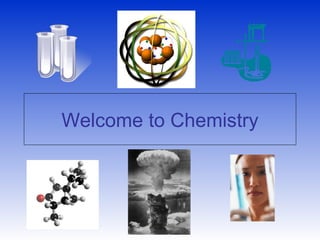
Chemistry Chapter 1
- 4. Chemistry organic chemistry inorganic chemistry analytical chemistry physical chemistry bio- chemistry
- 18. Development of the Periodic Table The modern periodic table of elements is mostly the work of Russian chemist Dmitri Mendeleev (1834-1907). It was set up in such a way so group elements in columns according to their properties, but also put them in ascending order according to their atomic number. Let ’s observe: The vertical columns are called groups ; the horizontal rows are called periods . Periodic Law : when elements are arranged in order of increasing atomic number, there is a periodic repetition of their physical & chemical properties.
- 19. The vertical columns are called groups , or families . There are 18 groups on the periodic table. Groups
- 20. The horizontal rows are called periods . Periodic Law : when elements are arranged in order of increasing atomic number, there is a periodic repetition of their physical & chemical properties.
- 21. Periodic Trends Elements in the same group : physically and chemically similar Elements in the same period : ordered in increasing size and atomic number.
- 22. Metals Characteristics of metals: excellent conductors of heat and electricity, very reactive, usually make positive ions when dissolved in solution, mix well to make alloys.
- 23. Alkali Metals Group 1A: Li, Na, K, Rb, Cs, Fr. Does not include hydrogen. ▪ They are very reactive because of the lone electron in their outer shell. ▪ Very shiny and light in weight. http://www.youtube.com/watch?v=OFG4Yr7lQzw&feature=related http://www.youtube.com/watch?v=uqDWbknpiVk&feature=related
- 24. Alkali Earth Metals Group 2A: Be, Mg, Ca, Sr, Ba, Ra ▪ Not as reactive as alkali metals, but form bonds very easily.
- 25. Transition Metals Have a special electron shell arrangement where two of their outer shells are not full. This allows them to bond to many other elements in a variety of shapes.
- 26. Halogens Have an outer shell that is almost full, therefore very reactive. Often bond with metals and elements from group one (alkali metals). When an halogen combines with another element, the resulting compound is called a halide .
- 27. Inert Gases (Noble gases) Include: He, Ne, Ar, Kr, Xe, Rn. Have a full outer shell and are very unreactive , hence the title “inert”.
- 28. Metalloids Metalloids are found on the periodic table between the metals and non-metals. Appropriately, they exhibit characteristics of both metals and non-metals.
- 29. Nonmetals Many nonmetals are gases at room temperature: N; O; F; Cl . These are elements that are poor conductors of heat and electricity .
Notas del editor
- Use kids as matter. Composition – what you ’re made of. Hair, eyes, ears, arms, legs, feet… structure- what order is that stuff in. ok its all in the same order but blonde vs brunette..short vs. tall. We’re all made up of the same parts but in different ways (elements). Properties..tall = good at basketball maybe or smart..some could change and some stay the same. Get stronger (lift weights) how much energy are you expending to do so? What is it made of? How is it put together? How do those things make it unique? How can it change..and at what cost (energy)?
- Piece of paper…crumple it, rip it, cut it..still paper. Light it on fire..not paper anymore. (color often a good indicator or chemical change)
- Think of it like speed..60mph is always 60mph even if I was accelerating or deccerlating